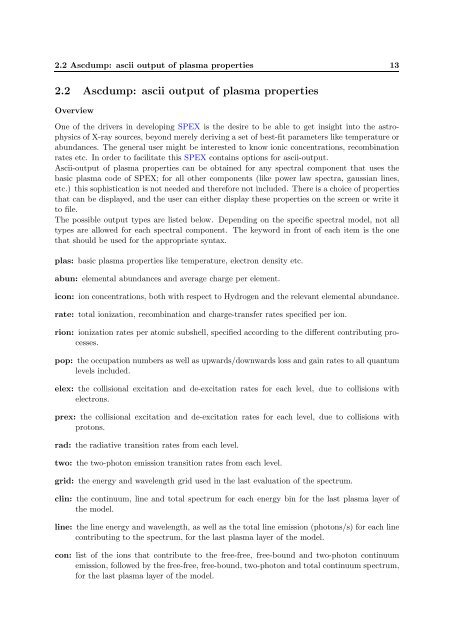SPEX Reference manual (PDF) - SRON
SPEX Reference manual (PDF) - SRON
SPEX Reference manual (PDF) - SRON
You also want an ePaper? Increase the reach of your titles
YUMPU automatically turns print PDFs into web optimized ePapers that Google loves.
2.2 Ascdump: ascii output of plasma properties 13<br />
2.2 Ascdump: ascii output of plasma properties<br />
Overview<br />
One of the drivers in developing <strong>SPEX</strong> is the desire to be able to get insight into the astrophysics<br />
of X-ray sources, beyond merely deriving a set of best-fit parameters like temperature or<br />
abundances. The general user might be interested to know ionic concentrations, recombination<br />
rates etc. In order to facilitate this <strong>SPEX</strong> contains options for ascii-output.<br />
Ascii-output of plasma properties can be obtained for any spectral component that uses the<br />
basic plasma code of <strong>SPEX</strong>; for all other components (like power law spectra, gaussian lines,<br />
etc.) this sophistication is not needed and therefore not included. There is a choice of properties<br />
that can be displayed, and the user can either display these properties on the screen or write it<br />
to file.<br />
The possible output types are listed below. Depending on the specific spectral model, not all<br />
types are allowed for each spectral component. The keyword in front of each item is the one<br />
that should be used for the appropriate syntax.<br />
plas: basic plasma properties like temperature, electron density etc.<br />
abun: elemental abundances and average charge per element.<br />
icon: ion concentrations, both with respect to Hydrogen and the relevant elemental abundance.<br />
rate: total ionization, recombination and charge-transfer rates specified per ion.<br />
rion: ionization rates per atomic subshell, specified according to the different contributing processes.<br />
pop: the occupation numbers as well as upwards/downwards loss and gain rates to all quantum<br />
levels included.<br />
elex: the collisional excitation and de-excitation rates for each level, due to collisions with<br />
electrons.<br />
prex: the collisional excitation and de-excitation rates for each level, due to collisions with<br />
protons.<br />
rad: the radiative transition rates from each level.<br />
two: the two-photon emission transition rates from each level.<br />
grid: the energy and wavelength grid used in the last evaluation of the spectrum.<br />
clin: the continuum, line and total spectrum for each energy bin for the last plasma layer of<br />
the model.<br />
line: the line energy and wavelength, as well as the total line emission (photons/s) for each line<br />
contributing to the spectrum, for the last plasma layer of the model.<br />
con: list of the ions that contribute to the free-free, free-bound and two-photon continuum<br />
emission, followed by the free-free, free-bound, two-photon and total continuum spectrum,<br />
for the last plasma layer of the model.

















